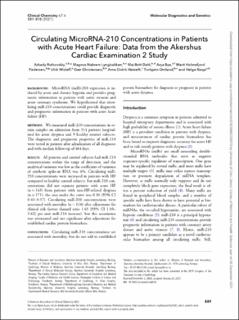| dc.contributor.author | Rutkovskiy, Arkady | |
| dc.contributor.author | Lyngbakken, Magnus | |
| dc.contributor.author | Dahl, Mai Britt | |
| dc.contributor.author | Bye, Anja | |
| dc.contributor.author | Pedersen, Marit Holmefjord | |
| dc.contributor.author | Wisløff, Ulrik | |
| dc.contributor.author | Christensen, Geir Arve | |
| dc.contributor.author | Høiseth, Arne Didrik | |
| dc.contributor.author | Omland, Torbjørn | |
| dc.contributor.author | Røsjø, Helge | |
| dc.date.accessioned | 2022-02-28T14:52:08Z | |
| dc.date.available | 2022-02-28T14:52:08Z | |
| dc.date.created | 2021-06-23T09:41:35Z | |
| dc.date.issued | 2021 | |
| dc.identifier.citation | Clinical Chemistry. 2021, 67 (6), 889-898. | en_US |
| dc.identifier.issn | 0009-9147 | |
| dc.identifier.uri | https://hdl.handle.net/11250/2981826 | |
| dc.description.abstract | Background MicroRNA (miR)-210 expression is induced by acute and chronic hypoxia and provides prognostic information in patients with aortic stenosis and acute coronary syndrome. We hypothesized that circulating miR-210 concentrations could provide diagnostic and prognostic information in patients with acute heart failure (HF). Methods We measured miR-210 concentrations in serum samples on admission from 314 patients hospitalized for acute dyspnea and 9 healthy control subjects. The diagnostic and prognostic properties of miR-210 were tested in patients after adjudication of all diagnoses and with median follow-up of 464 days. Results All patients and control subjects had miR-210 concentrations within the range of detection, and the analytical variation was low as the coefficient of variation of synthetic spike-in RNA was 4%. Circulating miR-210 concentrations were increased in patients with HF compared to healthy control subjects, but miR-210 concentrations did not separate patients with acute HF (n = 143) from patients with non-HF-related dyspnea (n = 171): the area under the curve was 0.50 (95% CI 0.43–0.57). Circulating miR-210 concentrations were associated with mortality (n = 114) after adjustment for clinical risk factors (hazard ratio 1.65 [95% CI 1.03–2.62] per unit miR-210 increase), but this association was attenuated and not significant after adjustment for established cardiac protein biomarkers. Conclusions Circulating miR-210 concentrations are associated with mortality, but do not add to established protein biomarkers for diagnosis or prognosis in patients with acute dyspnea. | en_US |
| dc.language.iso | eng | en_US |
| dc.publisher | Oxford University Press | en_US |
| dc.rights | Navngivelse 4.0 Internasjonal | * |
| dc.rights.uri | http://creativecommons.org/licenses/by/4.0/deed.no | * |
| dc.title | Circulating MicroRNA-210 Concentrations in Patients with Acute Heart Failure: Data from the Akershus Cardiac Examination 2 Study | en_US |
| dc.type | Peer reviewed | en_US |
| dc.type | Journal article | en_US |
| dc.description.version | publishedVersion | en_US |
| dc.source.pagenumber | 889-898 | en_US |
| dc.source.volume | 67 | en_US |
| dc.source.journal | Clinical Chemistry | en_US |
| dc.source.issue | 6 | en_US |
| dc.identifier.doi | 10.1093/clinchem/hvab030 | |
| dc.identifier.cristin | 1917857 | |
| cristin.ispublished | true | |
| cristin.fulltext | original | |
| cristin.qualitycode | 2 | |

